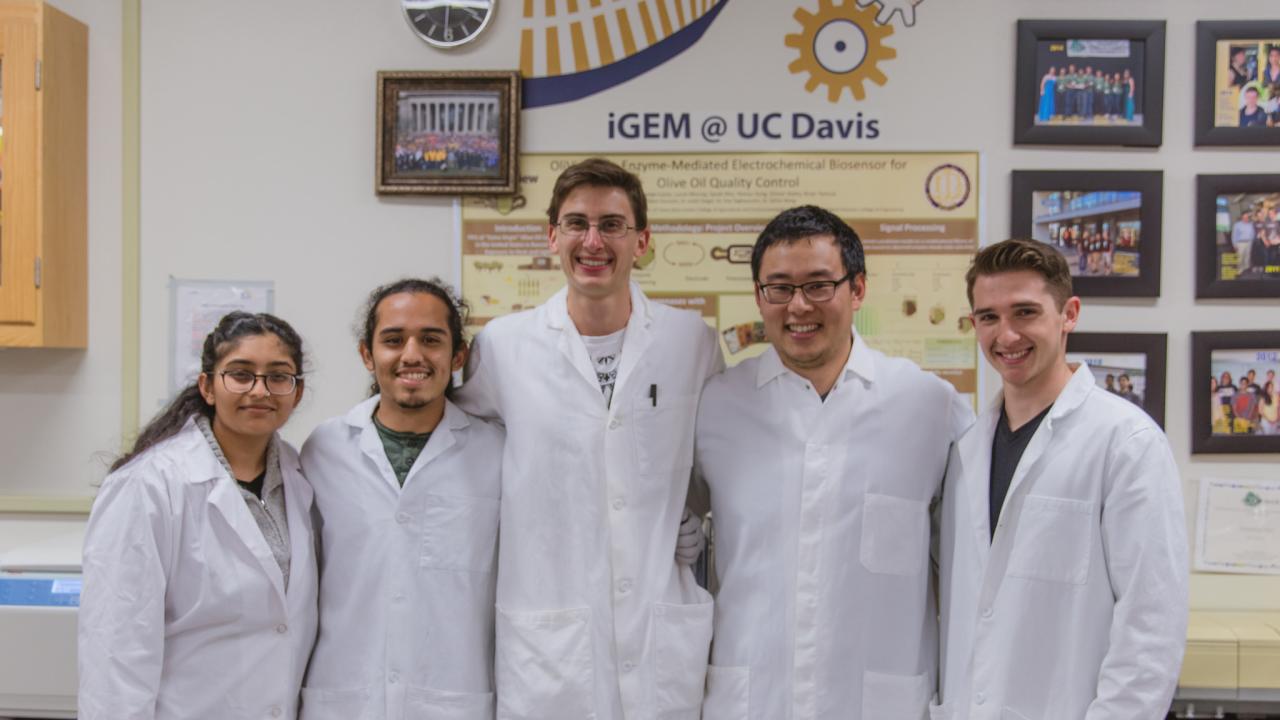
Innovation Is a ‘TEAM’ Effort at UC Davis Bioinnovation Lab
Latest maker-space makes a difference for student-researchers and innovators
Looking around at the academic posters, pictures and accolades on its walls, it’s hard to believe the UC Davis TEAM biology lab’s only been around since 2014.
“We host hands-on classes ranging in topics from synthetic biology to sustainable materials, entrepreneurs are building foundational technologies for their companies, student-researchers are investigating applications of microfluidics, bioprinting and molecular biology, and undergraduate teams are competing in international competitions and winning international honors, ” said TEAM Lab Manager Andrew Yao. “With all of this great work already happening, I can’t wait to see what the future brings!”
The TEAM lab work keeps Yao constantly on the go, he is everywhere around the lab from advising student and entrepreneurial teams, ensuring safety procedures are followed, and maintaining laboratory equipment, his constant movements are soundtracked by the soothing whirr of centrifuges.
“I myself was a UC Davis student — I got my B.S. in biomedical engineering and M.S. in molecular biology,” he said. “I’ve been part of this TEAM lab from its beginning, and I’m excited to help our lab be a leader of the biological maker movement at UC Davis, the greater Sacramento community and the world.”
The secret's out
Begun as a sister site of the popular UC Davis electrical/mechanical TEAM lab housed in the Genome and Biomedical Sciences building, the molecular/biological TEAM lab is in a small, unassuming room on the university’s Academic Surge building’s second floor. The room is packed with research-lab equipment – bought, donated or scavenged — so student-researchers and classes alike can work on such projects as:
- Building a customized 3D bioprinter
- Characterization of motile defects linked to mutations in an Alzheimer’s linked gene in C. elegans
- Building 3D-printed microfluidic devices with customized micro-controllers
- Surveying the microbiome of nectar
- Engineering an improved genetic oscillator.
Yao credits TEAM faculty co-director Marc Facciotti with the idea of extending rapid prototyping to include making using biological materials.
“We initially pictured the lab to be a mirror image of the electrical/mechanical TEAM lab, but being located in a space designated for instruction, the teaching activities really took off,” said Yao.
“Freshmen immediately can get started here with hands-on research,” he added. “They don’t have to be an upperclassman or in graduate school to pursue ideas and experiments in biology. We strive to teach all students — no matter their background — key laboratory skills and encourage each to think critically about how biological questions can be answered through experimentation.”
Yao noted the lab’s not only trying to foster students’ curiosities in biology, but also to give them the experimental tools to pursue exploration of biology with their own hands and minds, which otherwise would have never left the textbook.
“We believe these skillsets create curious, confident, adaptable and persistent students set up for success not only as a student at UC Davis, but also after they leave campus into their professional lives,” he said.
Leaders with the Biology Innovation Group – a campus club – helped spread the word about the new lab, plus collaborations with faculty including Dr. Christina Cogdell from the Department of Design, BioCurious, a community biomaker lab, helped seed a number of the initial student project ideas. Now the lab is going 10 a.m. to 8 p.m. throughout the academic year, serving hundreds of student researchers from all four colleges on campus.
“It’s fun to see so much diverse activity in the space!” said Yao.
Action-packed lab
A recent visit to the lab bore out Yao’s bustling description: Even on an otherwise quiet morning, the TEAM lab was in action. Members of the university’s iGEM (International Genetically Engineered Machine Competition) team were hard at work engineering mammalian cells – a new capability at the lab — for a stress-biosensor entry in this fall’s international contest. Elsewhere in the lab, student-researchers discussed and explored using biodegradable bacterial-based material grown on agricultural waste in a wide variety of clothing and personal-care applications such as colorful leather-like cloth, recycle-at-the-end-of-the-fashion-season shoes and feather-soft diapers.

"We’re working to create a circular lifestyle for these types of products,” said sophomore researcher Jolee Nieberding-Swanberg. “I’m excited about the interdisciplinary work we’re doing here – we’re combining science, art and design.”
And the students’ work is getting noticed: Among the student-researchers’ honors, Nieberding-Swanberg and her peers won the best science award and placed second at the international Biodesign Challenge with their innovative biocellulose-based diaper products, and the very first iGEM team to work in the lab won the 2014 international contest with their enzyme-based electrochemical biosensor that checks if olive oil is rancid. What’s more, several other student projects have gone on to become full-fledged business ventures including a plastic-recycling process, a device that catalyzes the production of engineered disease cell-lines and an affordable spectrophotometer.
“We’ve also proven to be a go-to facility for student entrepreneurs coming from other innovation centers around campus, such as students from the College of Engineering Student Startup Center who don’t have access to a research lab,” said Yao. “We’re here for all students: No matter your background, experience level or major, we want to help you explore and pursue projects in biology.”
Looking forward to the future
While Yao’s thrilled with the lab’s work and students’ progress in just these past few years, he looks forward to continue increasing the number of student activities in the lab: more hands on courses, more project ideas, more entrepreneurs, and — most importantly — more students in the lab.
“The TEAM team is committed to helping students ideate and create everything from molecules to machines,” he said. “It’s truly something new, every day.”
For more information on the TEAM biology lab, including services, equipment, donations, pricing and appointments, please visit team.ucdavis.edu.
